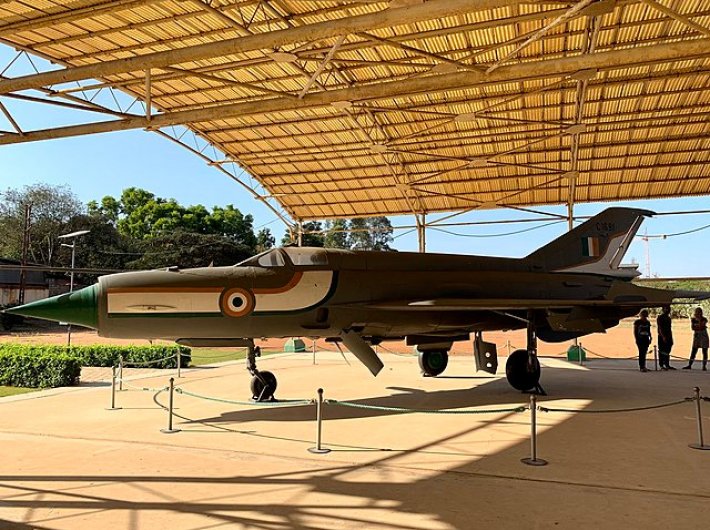CHECKS & BALANCES: Does MiG-21 have a poor track record? A discussion with Air Chief Marshal B S Dhanoa, Former Chief of the Air Staff, Air Marshal Navkaran Jeet Singh Dhillon, Air Marshal SK Ghotia, and Wing Commander Rajiv Battish
Does MiG-21 have a poor track record? Here is the gist of an online discussion held with Air Chief Marshal B S Dhanoa, Former Chief of the Air Staff, Air Marshal Navkaran Jeet Singh Dhillon, Air Marshal SK Ghotia, and Wing Commander Rajiv Battish.
In India's military capability, on one hand, our country has strengthened the security of the borders by including aircraft like Rafale in the fleet of Indian Air Force, while on the other hand questions are being raised on the capability of old fighters like MiG-21. Why is the IAF not doing away with the (in)famous aircraft? Although the aircraft is the backbone of the force in some ways, it is also considered accident-prone.
Talking about the phasing out of Mig-21 from IAF Air Chief Marshal B S Dhanoa, Former Chief of the Air Staff, said that the MiG-21 has become obsolete and will be phased out in a few years. The process of phasing out has been taking time, as there is a shortage of squadrons with the IAF.
“They (MiG-21) will be phased out gradually. In the frontline fighter Rafael has taken the position replacing the MiG-21. We have Su-30, Rafael, Mirage 2000 upgraded and also MiG-29 upgraded. If we ground an aircraft which has life left, it means there are safety issues. We are not further extending its life,” ACM Dhanoa said. He also mentioned that every crash is not because of the problem of the aircraft, some happen because of other factors. “I will not say the MiG-21 is a difficult aircraft but it is a challenging aircraft to fly. It is not a forgiving aircraft so the pilot has to be on his toes.”
You can watch the discussion here too: https://www.youtube.com/watch?v=tPaDG5AbL3U
In 1963, the IAF inducted MiG-21 aircraft in its fleet at the cost of about Rs.177 crore. Then the IAF had bought 874 supersonic fighter aircraft MiG-21 from the then USSR. In 1967 Hindustan Aeronautics Limited (HAL) started production of this aircraft. The USSR stopped manufacturing it in 1985, but India continued to upgrade it and has been using it till date. Even after six decades, the IAF has not been able to phase it out. The Soviet jets gained the reputation of being the backbone of the Force but the number of crashes raised doubts about safety concerns.
Air Marshal Navkaran Jeet Singh Dhillon shared his opinion, “MiG-21 was designed as a high-speed, high-altitude air interceptor and it has done its job for almost six decades for the country and the Indian Air Force – be it the victory in the 1971 war, Kargil war or Balakot Ops. We must remember it was this MiG-21, which took the better off F-16, and shot the aircraft out of the skies in the post-Balakot strike in air combat. Right from 1983 after La Fontaine committee and the committee set up by the late Abdul Kalam had recommended that the IAF must get advanced jet trainer on priority but unfortunately we got the advanced jet trainer only around 2005-06 and in this four decades we have used these formidable, versatile fighter not only in its combat role but also to train the rookie pilots. In initial stages all of them have been trained on MiG-21.”
Air Marshal Dhillon also agreed that the MiG-21 is not the right aircraft to train the rookie pilots. He said, “The loss could have been avoided. If you want to train well you have to take certain risks, some sort of accidents will always happen.” He also stressed upon the strength of the squadron with the Force. He said the IAF had strength of 42 squadrons in the late 1990s which has come down to about 30 and it may come down further by 2-3 squadrons. He said, “Just to put it in the right perspective the total budget of Indian Air Force in 2021-22 was Rs 94,000 crore, out of that Rs 48,000 crore was earmarked for modernization of the Force and just to tell you that cost of Rafale squadron which we just inducted is Rs 30,000 crore. The cost of c-17 is about Rs 2,400 crore, the cost of c-130 is Rs 1,300 crore. So in this Rs 48,000 crore, the Indian Air Force has to buy fighter, transport, helicopter, missiles, drones and other equipment.”
Till date more than 400 MiG-21s have crashed (since 1971-72), killing over 200 pilots and another 50 people on the ground. The grieving families of the pilots who died in crashes have continuously been raising concerns about the danger tagging along with the aircraft.
Air Marshal SK Ghotia said that in India we need to optimize our resources as far as the weaponization of the armed forces is concerned. He said, “You cannot have an unlimited budget. Your wish list may be very high, I would like to have the best which is available in the world but that is not possible because of our constraints and our government wanting to sort of distribute all the wealth that is there amongst the people for their upliftment as that is also very important. We must understand that we must optimize and make the best use of the assets that we have. That's what we are doing. As and when the life finishes the aircraft is phased out and the aircraft which have got upgraded still have about 7-8 years of life to go. They are being optimally utilized.”
He added that the MiG-21, because of its highest landing speeds, requires pilots to master the aircraft well. He said, "Once a pilot masters this fighter jet, he will never fall short of skills in piloting any other aircraft." Having flown the aircraft for a long time, Air Marshal Ghotia did not forget to mention Group Captain Abhinandan Varthaman. He said, “Abhinandan was a student officer when I was commanding the Air Force Station in Bhuj. He trained on the MiG-21. He flew the MiG-21 Bison in the Balakot action. It was a Bison Aircraft that shot down an F-16. One can understand the kind of capability that the aircraft possesses today, it is second to none.”
If mastering the art of flying the jet could prevent the crashes, then why did the IAF use it for training purposes? Wing Commander Rajiv Battish said, “If we didn't have a trainer, we improvised ourselves. The Indian government thought that if we do not have a trainer, then something has to be done. You will work with the training tools we have. If in the years 1970-80 we did not have money, we did not have trainers, then we had to train our air force in some way. We had to be ready for war but we did pay the price for that.”
Air Marshal Dhillon added, “We used this aircraft for training roles till about 2013-14. At this moment the aircraft is not being used for training. So we would like to utilize the aircraft because we have to keep our combat forces in quality as well as in quantity. We should have 67 squadrons as per the studies carried out in 1960-70 but we got only approximately 30 squadrons. We cannot afford to reduce the numbers further if the aircraft has still got life left. The budgets will always remain like this. Be it any government, NDA or the UPA, would like to spend more money on health, education and infrastructure.”
Being hopeful, Air Marshal Dhillon said, “With ‘Atmanirbhar’ we may have aircraft made in India, but it may take 15-20 years. That is the reason why IAF has signed the contract for Tejas. We are already making medium combat aircraft. The government has said that the import of fighter aircraft is almost done. Probably we may get just two more squadrons of Rafael. Because of the financial constraints, I think the import of fighter aircraft is a big no-no. Probably, we will make F-16 or F-18. The cost will still be high but at least we will be having jobs for the Indians and the precious foreign exchange will not go out.
“There is no doubt we need extra squadrons; we have to reach the figure of 42. If you ask my personal opinion, I don't think IAF will ever reach the figure of 42 because the whole concept is changing. The future war is going to be not only fighter aircraft oriented. Fighter aircraft will remain the fulcrum, but the war is slowly moving towards Unmanned Combat Aerial Vehicle. It is also moving to missile era, surface to surface, surface to air, air to surface, ballistic missile, drones and the cyber warfare.”

